The following distribution and phytogeographic information concerning Acacia sens. lat. is provided here:
- Worldwide distribution of genera comprising Acacia sens. lat.
- Distribution of Australian species of Acacia
- Geographic patterns of species-richness of Acacia sens. lat. within Australia
Worldwide distribution of Acacia sens. lat.
Acacia sens. lat.is an informal term that incorporates the genera Acacia (sens. str.), Acaciella, Mariosousa, Senegalia and Vachellia. This group contains 1511 described species that are distributed in tropical, subtropical and warm temperate parts of the world, namely, Africa, Asia, the Americas and the Australia – Pacific region. Further information concerning species numbers is provided elsewhere on WorldWideWattle.
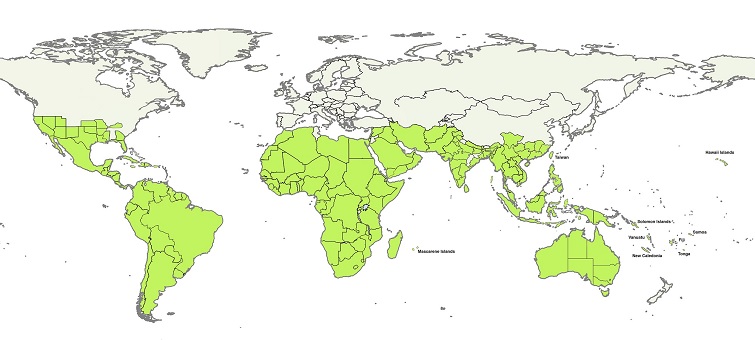
Distribution of Acacia sens. lat. globally (1511 species). Species number derived from WorldWideWattle Search (continuously updated).
Acacia (sens. str.)
This enormous genus is largely confined to Australia. There are 19 species (20 taxa, including one possible new taxon) that occur naturally outside Australia. These species are mostly in southeast Asia (north to the Taiwan, but there is uncertainty about whether or not A. confusa is native to Taiwan, although it is native to the neighbouring Philippines; and islands of the Pacific (east to Hawaii) Seven of the Asia-Pacific species also occur in Australia. The one species (A. heterophylla) from Mascarene Islands (Indian Ocean) was recently shown by Le Roux et al. (2014) to be conspecific with the Hawaiian species A. koa and to have colonised the Mascarene archipelago directly from the Hawaiian Islands ≤ 1.4 million yr ago. The extra-Australian species are listed below; most of these taxa are taxonomically reviewed by Pedley (1975) and their phylogeny discussed by Brown et al. (2012). Further information on the distribution of Acacia within Australia is given below.
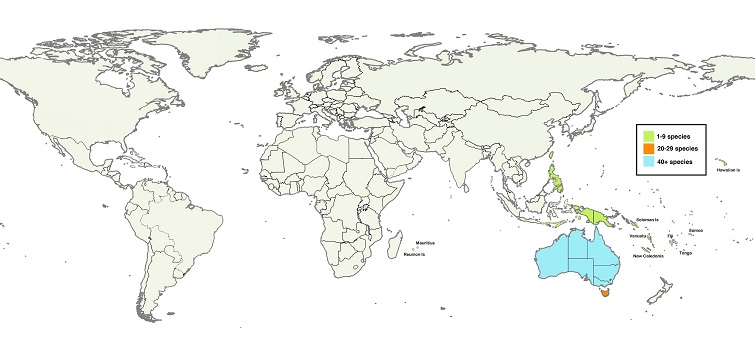
Distribution of Acacia (1084 species). Species number derived from WorldWideWattle Search feature (continuously updated).
Acacia taxa that occur naturally outside of Australia
Taxon |
Distribution |
Notes |
|---|---|---|
Acacia auriculiformis |
Australia (N.T. & Qld); New Guinea (Papua New Guinea & West Papua); Moluccas (Kei Is.) |
|
Acacia confusa |
Philippines; ?Taiwan |
It is not known if this species is native in Taiwan or not (WorldWideWattle). |
Acacia crassicarpa |
Australia (Qld); Papua New Guinea |
|
Acacia heterophylla |
Mauritius; Reunion Is |
See note above. |
Acacia kauaiensis |
Hawaiian Islands |
|
Acacia koa |
Hawaiian Islands |
|
Acacia koaia |
Hawaiian Islands |
|
Acacia leptocarpa |
Australia (W.A., N.T. & Qld); Papua New Guinea |
|
Acacia mangium |
Australia (Qld); Moluccas (Au Is.); New Guinea (Papua New Guinea & West Papua) |
|
Acacia mathuataensis |
Fiji |
|
Acacia oraria |
Australia (Qld); Lesser Sunda Islands (Alor, Flores & Timor) |
Cultivated and seemingly also indigenous on Lesser Sunda Islands (fide Nielsen 1992). |
Acacia peregrinalis |
New Guinea (Papua New Guinea & West Papua) |
|
Acacia pubirhachis |
Australia (Qld); Papua New Guinea |
|
Acacia richii |
Fiji |
|
Acacia simsii |
Australia (N.T. & Qld); New Guinea (Papua New Guinea & West Papua) |
|
Acacia simplex |
Fiji; New Caledonia; Samoa; Tonga; Vanuatu; Mariana Is. (uncertain) |
|
Acacia spirobis subsp. spirobis |
New Caledonia; Vanuatu |
|
Acacia spirobis subsp. solandri |
Australia (Qld); Papua New Guinea |
|
Acacia wetarensis |
Lesser Sunda Is (Wetar) |
|
Acacia sp. Wetar (A. aff. elacantha) |
Lesser Sunda Is (Wetar) |
A possible new species allied to A. elachantha (fide McDonald & Maslin 1997) |
Acaciella
This small genus ranges from the southern States of the U.S.A. south to Argentina, with the highest concentration of species in Mexico.
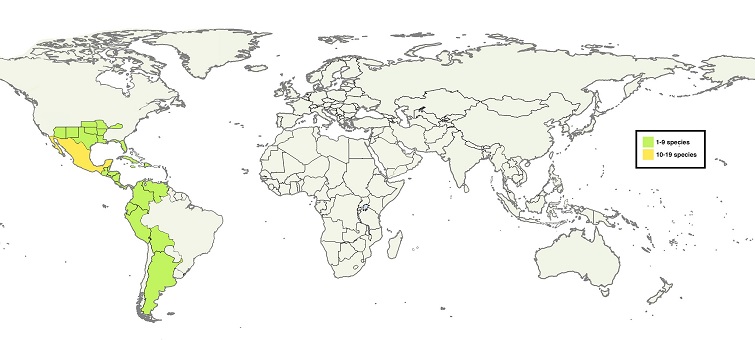
Distribution of Acaciella (15 species). Species number derived from WorldWideWattle Search feature (continuously updated).
Mariosousa
This small genus extends from Arizona in southern U.S.A. to Costa Rica, with the highest concentration of species in Mexico.
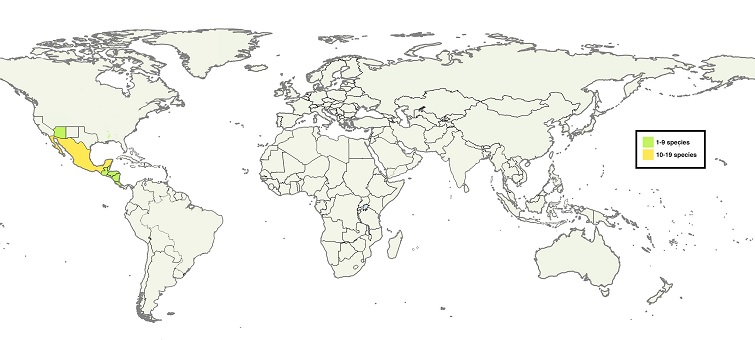
Distribution of Mariosousa (14 species). Species number derived from WorldWideWattle Search feature (continuously updated).
Parasenegalia
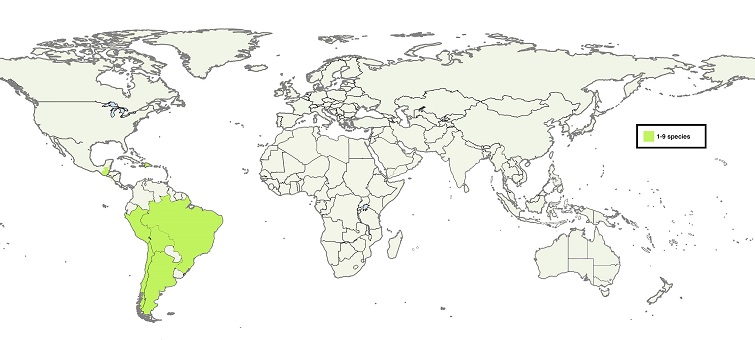
Distribution of Parasenegalia (11 species). Species number derived from WorldWideWattle Search feature (continuously updated).
Pseudosenegalia
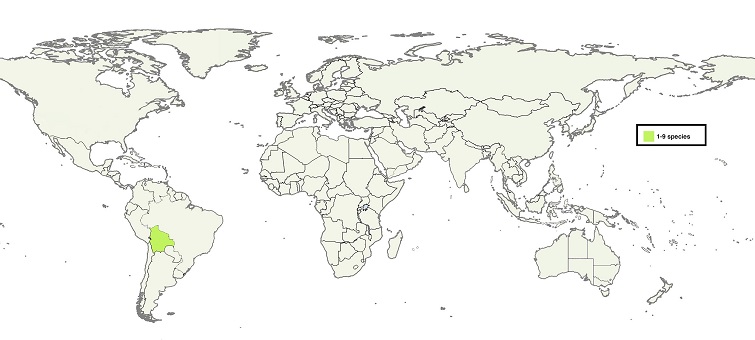
Distribution of Pseudosenegalia (2 species). Species number derived from WorldWideWattle Search feature (continuously updated).
Senegalia
A pan-tropical group with highest species concentrations in the Americas, namely, South America (Brazil and Bolivia) and Central America (Mexico). Outside the Americas the highest species numbers occur in northeast and eastern Africa (e.g. Ethiopia, Tanzania and Mozambique).
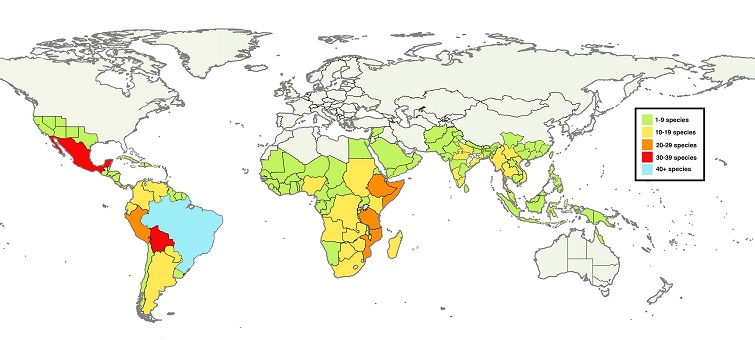
Distribution of Senegalia (221 species). Species number derived from WorldWideWattle Search feature (continuously updated).
Vachellia
A pan-tropical group with highest species concentrations in Mexico and in northeast to southern Africa (e.g. Ethiopia, Tanzania and South Africa).
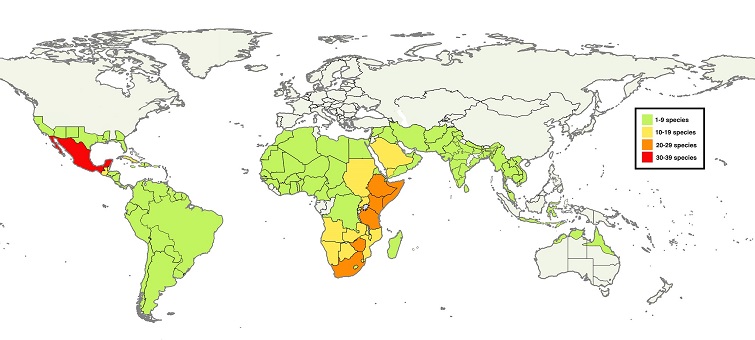
Distribution of Vachellia (164 species). Species number derived from WorldWideWattle Search feature (continuously updated).
Distribution of Australian species of Acacia
Species distribution maps (small scale dot maps) for Australian Acacias are provided in WATTLE (Maslin 2001 & 2013) and the Flora of Australia (Orchard & Wilson 2001 and 2001a). These maps may be accessed via the WorldWideWattle Species Gallery.
Species distribution maps, generated in real-time and based on specimen point-source data held by major Australian herbaria, are available through Australia’s Virtual Herbarium. Note: While AVH data is comprehensive, users should be aware that not all data points have been verified as to accuracy of specimen identification and distribution.
Distribution maps based on species occurrences in 1 x 1.5 degree grids are provided for many Australian Acacias in Maslin & Pedley (1982). However, not all species currently recognized for Australia are covered by these maps, furthermore, the maps are now a little out of date.
Maps of South Australian species are given in Whibley & Symon (1992) and of the Victorian species in Entwistle et al. (1996). For Western Australian species visit the FloraBase website.
Geographic patterns of species-richness of Australian Acacias
Within Australia Acacia species are represented in most ecosystems where they occupy a wide range of soil types within many climatic regimes.
The patterns of species richness of Acacia within Australia, based on individual species distributions, are discussed by Hnatiuk & Maslin (1988) and Maslin & Pedley (1988) and are shown below in a series of isoflor maps (i.e. species-richness maps), most of which are reproduced below. The Hnatiuk & Maslin study showed that precipitation was more important than temperature in governing Acacia distribution patterns on a national scale (NB. edaphic and geological variables were not included in the study). Similar results are shown by González-Orozco et al. (2014).
Regional phytogeographic studies of the Australian Acacia flora include the following:
- Western Australia: Hopper & Maslin (1978), Maslin (1982 – Pilbara region), Maslin (1982a – Wongan Hills), Hnatiuk et al. (1983)
- Queensland: Pedley (1978)
- Central Australia: Maslin & Hopper (1982)
- Northern Australia: Hnatiuk & Pedley (1985)
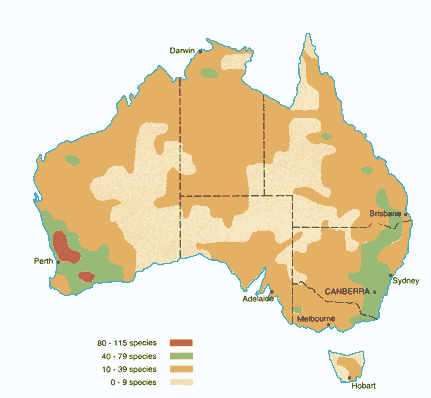
Areas of species-richness of Acacia sens. lat. within Australia. Note: The very few species of Senegalia and Vachellia in Australia contribute scarcely anything to this pattern which is dominated by species of Acacia (sens. str.). This map
was originally published in Maslin (1997).
Major centres of species richness
The two major areas of species richness for Acacia in Australia are:
- The semi arid inland region of southwest Western Australia along the boundary separating the Arid Zone from the more humid South West Botanical Province.
- Along the tablelands associated with the Great Dividing Range south of the Tropic of Capricorn in eastern Australia.
These areas of richness are dominated by species of section Acacia (syn. section Phyllodineae).
Secondary centres of species richness
Important secondary centres of richness occur in northern and north eastern Australia, a number of the rocky tablelands of the Arid Zone and in western Victoria. It is species of section Juliflorae that are primarily responsible for these secondary centres of richness.
Species poor areas
The sandy deserts and riverine areas separating the centres of richness are species poor even though, in the deserts at least, Acacia is a common element of the landscape.
Species-richness maps for Australian species of Acacia sens. lat.
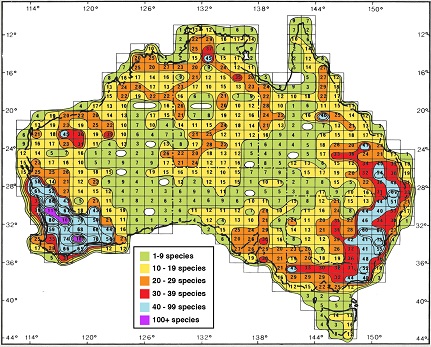
Isoflor map of Acacia sens. lat. in Australia showing patterns
of species richness (view
a larger version). Numbers indicate species recorded in each 1 x
1.5 degree grid cell; isoflor interval is 10. Although the total
number of described, accepted species recorded for Australia now exceeds 1,000, the basic geographic patterns depicted by this map (which
was based on 840 species) remain basically the same. Note: The very few species of Senegalia and Vachellia in Australia contribute scarely anything to this pattern which is dominated by species of Acacia (sens. str.). The map was
originally published by Maslin & Hnatiuk (1987) and reproduced in
Hnatiuk & Maslin (1988).
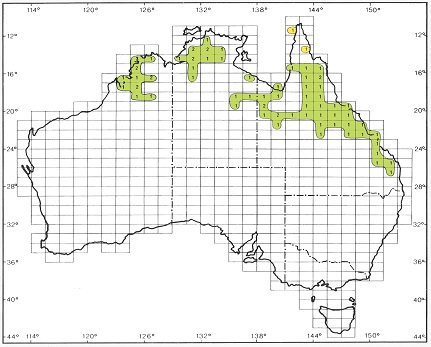
Isoflor map of Senegalia and Vachellia combined in Australia (view
a larger version). Numbers indicate species recorded in each grid;
isoflor interval is 10. Note: Although Australian Vachellia now number 9 species and Senegalia 2 species the basic
geographic patterns depicted by this map (which was based on 6 and 1
species respectively) remain similar. The map was originally
published by Maslin & Hnatiuk (1987) and reproduced in Hnatiuk &
Maslin (1988).
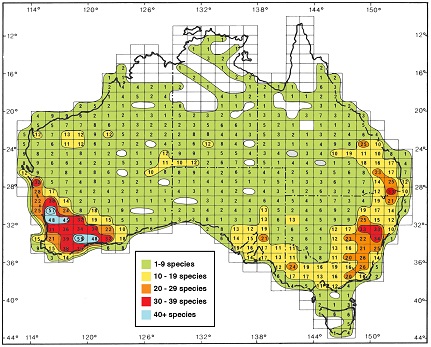
Isoflor map of Acacia section Acacia (syn. section Phyllodineae) in Australia
(view
a larger version). Numbers indicate species recorded in each grid;
isoflor interval is 10. Note: Although section Acacia now contains
420 species the basic geographic patterns
depicted by this map (which was based on 352 species, under section Phyllodineae) remain similar. The map was originally published by Maslin & Hnatiuk
(1987) and reproduced in Hnatiuk & Maslin (1988).
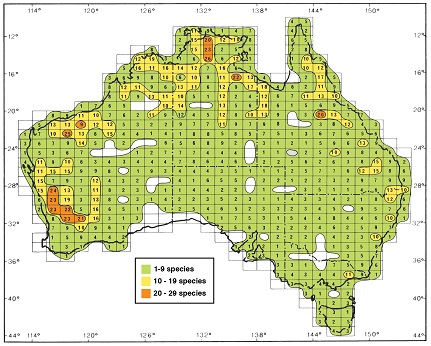
Isoflor map of Acacia section Juliflorae in Australia
(view
a larger version). Numbers indicate species recorded in each grid;
isoflor interval is 10. Note: Although section Juliflorae now contains
292 species the basic geographic patterns
depicted by this map (which was based on 219 species) remain similar. The map was originally published by Maslin & Hnatiuk
(1987) and reproduced in Hnatiuk & Maslin (1988).
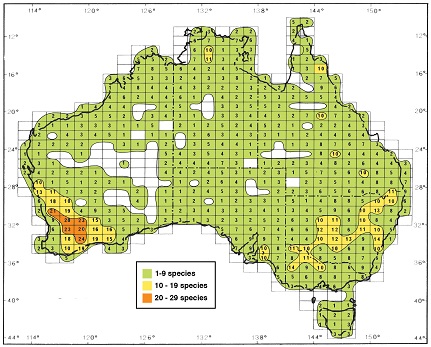
Isoflor map of Acacia section Plurinerves in Australia
(view
a larger version). Numbers indicate species recorded in each grid;
isoflor interval is 10. Note: Although section Plurinerves now contains 234 species the basic geographic patterns
depicted by this map (which was based on 178 species) remain similar. The map was originally published by Maslin & Hnatiuk
(1987) and reproduced in Hnatiuk & Maslin (1988).
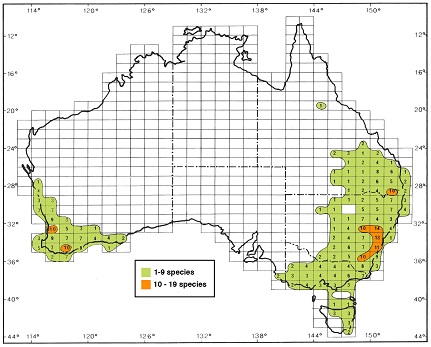
Isoflor maps of section Pulchellae and section Botrycephalae
in Australia (view
a larger version). Numbers indicate species recorded in each grid;
isoflor interval is 10. Note: Although section Botrycephalae now contains 45 species the basic geographic patterns depicted
by this map (which was based on 36 species) remain basically the same;
section Pulchellae currently contains 27 species, the same number
as when this map was constructed. The map was originally published by
Maslin & Hnatiuk (1987) and reproduced in Hnatiuk & Maslin (1988).
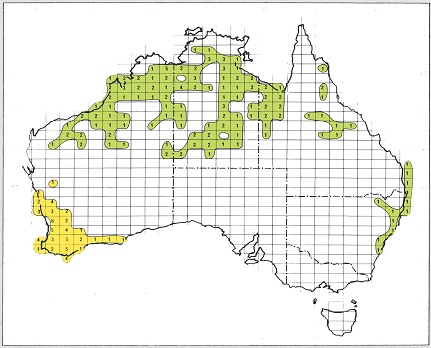
Isoflor maps of Acacia section Alatae and section Lycopodiifoliae
in Australia (view
a larger version). Numbers indicate species recorded in each grid;
isoflor interval is 10. Note: Although section Lycopodiifoliae now
contains about 24 species the basic geographic patterns
depicted by this map (which was based on 11 species) remain similar; section Alatae (an artificial group) currently contains
23 species, the same number as when this map was
constructed. The map was originally published by Maslin & Hnatiuk
(1987) and reproduced in Hnatiuk & Maslin (1988).
References
Brown, G.K., Murphy, D.J., Kidman, J. & Ladiges, P.Y. (2012). Phylogenetic connections of phyllodinous species of Acacia outside Australia are explained by geological history and human-mediated dispersal. Australian Systematic Botany 25: 390-403.
Entwistle, T.J., Maslin, B.R., Cowan, R.S. and Court, A.B. (1996). Mimosaceae. In: N.G. Walsh and T.J. Entwistle (eds) Flora of Victoria. Volume 3. (Inkata Press: Melbourne.)
González-Orozco, C.E., Laffan, S.W. & Miller, J.T. (2011). Spatial distribution of species richness and endemism of the genus Acacia in Australia. Australian Journal of Botany 59: 601-609.
Hnatiuk, R.J. and Maslin, B.R. (1988). Phytogeography of Acacia in Australia in relation to climate and species-richness. Australian Journal of Botany 36: 361-383.
Hnatiuk, R.J., Maslin, B.R. and D'Antuono. (1983). The distribution of Acacia (Mimosoideae) in Western Australia. Part 3. Numerical analysis of pattern and ecological correlations. Western Australian Herbarium Research Notes 8: 1-21.
Hnatiuk, R.J. & Pedley, L. (1985). Biogeography of Acacia in northern Australia. Proceedings of the Ecological Society of Australia 13: 33-42.
Hopper, S.D. and Maslin, B.R. (1978). Phytogeography of Acacia in Western Australia. Australian Journal of Botany 26: 63-78.
Jawad, J.T., Seigler, D.S. and Ebinger, J.E. (2000). A systematic treatment of Acacia coulteri (Fabaceae, Mimosoideae) and similar species in the New World. Annals of the Missouri Botanical Garden 87: 528-548.
Le Roux, J.J., Strasberg, D., Rouget, M., Morden, C.W., Koordom, M. & Richardson, D.M. (2014). Relatedness defies biogeography: the tale of two island endemics (Acacia heterophylla and A. koa). New Phytologist 204(1): 230–242.
Maslin, B.R. (1997). Australia’s golden future. Landscope 12(3): 16-22.
Maslin, B.R. (1982). Studies in the genus Acacia (Leguminosae: Mimosoideae) - 11. Acacia species of the Hamersley Range area, Western Australia. Nuytsia 4(1): 61-103.
Maslin, B.R. (1982a). Studies in the genus Acacia (Leguminosae: Mimosoideae) - 10. Acacia species of the Wongan Hills, Western Australia. Nuytsia 4(1): 29-46.
Maslin, B.R. (coordinator) (2001). WATTLE Acacias of Australia. CD ROM Publication. (Published by Australian Biological Resources Study, Canberra and Department of Conservation and Land Management, Perth).
Maslin, B. R. (2013) WATTLE2 Interactive Identification of Australian Acacia, ver. 2.1. (Dept. Environment and Conservation; Atlas of Living Australia.). Available on web at: www.lucidcentral.com.
Maslin, B.R. (2015). Synoptic overview of Acacia sensu lato (Leguminosae: Mimosoideae) in East and Southeast Asia. Gardens’ Bulletin Singapore 67(1): 231–250. 2015.
Maslin, B.R. and Hnatiuk, R.J. (1987). Aspects of the phytogeography of Acacia in Australia. pp. 443-457. In: Stirton, C.H. (ed.) 'Advances in Legume Systematics' Part 3. (Royal Botanic Gardens, Kew: England.)
Maslin, B.R. and Hopper, S.D. (1982). Phytogeography of Acacia (Leguminosae: Mimosoideae) in Central Australia. pp. 301-316. In: Barker, W.R. and Greenslade, P.J.M. (eds.) 'Evolution of the Flora and Fauna of Arid Australia.' (Peacock Publications: Adelaide.)
Maslin, B.R., Miller, J.T. and Seigler, D.S. (2003). Overview of the generic status of Acacia (Leguminosae: Mimosoideae). Australian Systematic Botany 16: 1-18.
Maslin, B.R. and Pedley, L. (1982). The distribution of Acacia (Leguminosae: Mimosoideae) in Australia. Part 1. Species distribution maps. Western Australian Herbarium Research Notes 6: 1-128.
Maslin, B.R. and Pedley, L. (1988). Patterns of distribution of Acacia in Australia. Australian Journal of Botany 36: 385-393.
McDonald, M W. & Maslin, B.R. (1997). A reappraisal of Acacia cowleana and allied taxa, including the description of a new species, A. elachantha, from the tropical dry-zone of Australia. Australian Systematic Botany 10: 303-320.
Nielsen, I.C. (1992). Acacia in Flora Malesiana 11: 34-64. (Foundation Flora Malesiana: The Netherlands.)
Orchard, A.E. and Wilson, A.J.G. (2001) (eds). Flora of Australia Volume 11A, Mimosaceae, Acacia part 1. (ABRS/CSIRO Publishing: Melbourne.)
Orchard, A.E. and Wilson, A.J.G. (2001a) (eds). Flora of Australia Volume 11B, Mimosaceae, Acacia part 2. (ABRS/CSIRO Publishing: Melbourne.)
Pedley, L. (1975). Revision of the extra-Australian species of Acacia subg. Heterophyllum. Contributions from the Queensland Herbarium 18: 1-24.
Pedley, L. (1978). A revision of Acacia Mill. in Queensland. Austrobaileya 1: 75-234.
Rico Arce, L. & Bachman, S. (2006). A taxonomic revision of Acaciella (Leguminosae,Mimosoideae). Anales del Jardin Botanico de Madrid 63(2): 189-244.
Whibley, D.J.E. and D.E. Symon (1992). Acacias of South Australia. (South Australian Government Printer: Adelaide.)